Lady Amaris Mimetes wrote:
Varon Netzah Mimetes wrote:
Which Tarzan though? Jane did love him, but she wouldn't marry him because she was already engaged.
Yes. This actually is the usual course of events in "beauty and the beast" stories in my experience... with the one major exception that I know of being "Beauty and the Beast" itself.
"Snow White and Rose Red" has the heroine marry the "beast" character (who's a most virtuous prince under an enchantment), and "Bluebeard"
starts with the female lead marrying the title character---and as I said, I think both of those stories are
far closer to "Beauty and the Beast" than
Tarzan is.
Varon Netzah Mimetes wrote:
I suppose this could be almost like an archetype story, similar to archetype characters.
The trouble---what I was trying to get at in my wail of "It's not that
simple ..."---is that for every story (of sufficient antiquity---there's only one Tarzan (ignoring recent fan-fiction) because Burroughs' creation is too recent to have gone through the folk process) any given proposed "archetype" purports to explain, there are often a half-dozen
versions of that story that contradict the theory, and a dozen more stories that it
ought to explain (because they're
so similar to the ones you started with) but can't. This is rather like (to introduce a math/physics joke---sorry, I was a computer science major ...) the "proof" that all odd numbers are prime: "1 is prime, 3 is prime, 5 is prime, 7 is prime, 9 is experimental error, 11 is prime, 13 is prime, so by extension all odd numbers are prime."
Lady Amaris Mimetes wrote:
I see value in finding patterns that we can work off of and expand, that resonate widely or even universally with an audience.
I agree ... but it's not helpful, and not good practice (I speak here as a sometime academic) to start with a
very few items from a class of items and then draw sweeping conclusions about
all items in that class from just those items. The reason I objected so verbosely is that if I were asked for "three stories that could be titled 'Beauty and the Beast'" (or however you want to phrase the criterion), I would
not have picked
Tarzan,
King Kong, or "The Hunchback of Notre Dame"; I would have picked "Snow White and Rose Red," then gone searching through the Andrew ang
Fairy books for the others I vaguely remember (which largely involve the prince and sometimes the princess getting turned into animals by their fairy guardians to reform their character)---and none of them fit the "all the same" generalizations you drew from your selected examples at
all well. And even "Beauty and the Beast" (the one item on your list where we don't have a single authoritative source) probably has many versions that don't fit it as well; such is the nature of the folk process.




